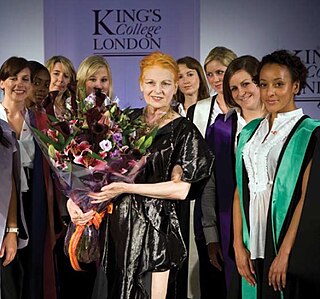
Graduation is the award of a diploma or academic degree, or the ceremony that is sometimes associated with it, in which students become graduates. The date of graduation is often called graduation day.

The square academic cap, graduate cap, cap, mortarboard or Oxford cap, is an item of academic dress consisting of a horizontal square board fixed upon a skull-cap, with a tassel attached to the centre. In the UK and the US, it is commonly referred to informally in conjunction with an academic gown as a "cap and gown". It is also sometimes termed a square, trencher, or corner-cap. The adjective academical is also used.

Academic dress is a traditional form of clothing for academic settings, mainly tertiary education, worn mainly by those who have obtained a university degree, or hold a status that entitles them to assume them. It is also known as academical dress, academicals, subfusc and, in the United States, as academic regalia.

The University of Oxford has a long tradition of academic dress, which continues to the present day.

The biretta is a square cap with three or four peaks or horns, sometimes surmounted by a tuft. Traditionally the three-peaked biretta is worn by Roman Catholic clergy and some Anglican and Lutheran clergy. A four-peaked biretta is worn as academic dress by those holding a doctoral degree from a pontifical faculty or pontifical university or faculty. Occasionally the biretta is worn by advocates in law courts, for instance the advocates in the Channel Islands.

A flat cap is a rounded cap with a small stiff brim in front, originating in Great Britain and Ireland. The hat is known in Ireland as a paddy cap, in Scotland as a bunnet, in Wales as a Dai cap, in New Zealand as a cheese-cutter, and in the United States as a driving cap. Cloths used to make the cap include wool, tweed, and cotton. Less common materials may include leather, linen, or corduroy. The inside of the cap is commonly lined for comfort and warmth.

The University of Cambridge has a long tradition of academic dress, which it traditionally refers to as academical dress. Almost every degree which is awarded by the university has its own distinct gown in addition to having its own hood. Undergraduates wear college gowns which have subtle differences enabling the wearer's college to be determined. Academic dress is worn quite often in Cambridge on formal, and sometimes informal, occasions, and there are a number of rules and customs governing when and how it is worn. Black gowns (undress) are worn at less formal events, while on special days full academical dress is worn, consisting of gown, hood and headdress with Doctors in festal dress. The university's officials also have ancient forms of academic dress, unique to the university.

A Tudor bonnet is a traditional soft-crowned, round-brimmed cap, with a tassel hanging from a cord encircling the hat. As the name suggests, the Tudor bonnet was popularly worn in England and elsewhere during Tudor times.

The peaked cap, service cap, forage cap, barracks cover or combination cap is a form of headgear worn by the armed forces of many nations, as well as many uniformed civilian organisations such as law enforcement agencies and fire departments. It derives its name from its short visor, or peak, which was historically made of polished leather but increasingly is made of a cheaper synthetic substitute.
The academic dress prescribed by the University of Bristol is a mixture of that prescribed by Cambridge and Oxford. Bristol has chosen, for graduates, to mainly specify Oxford-style gowns and Cambridge-style hoods. Unlike many British universities, the hood itself is to be "University red", lined with a specified colour. University red is defined to be Pantone 187. Bristol also specifies that undergraduates are to wear gowns "of the approved pattern" in certain circumstances, although the pattern itself is not specified. This is not too important since, in practice, undergraduates are never required to be gowned except when graduating.

In various European countries, student caps of different types are, or have been, worn either as a marker of a common identity, as is the case in the Nordic countries, or to identify the wearer as a member of a smaller body within the larger group of students, as is the case with the caps worn by members of German Studentenverbindungen, or student groups in Belgium.

As the oldest college in the United States, Harvard University has a long tradition of academic dress. Harvard gown facings bear crow's-feet emblems near the yoke, a symbol unique to Harvard, made from flat braid in colours distinctive of the wearer's qualification or degree. Crow's-feet are double for earned degrees, and triple for honorary degrees.

Academic dress prescribed at the University of Dublin and its sole constituent college, Trinity College, follows a relatively complex protocol which, nonetheless, shares some particular characteristics with other universities in Ireland and with the University of Oxford in the United Kingdom.

The academic dress of the United Kingdom and Ireland has a long history and has influenced the academic dress of America and beyond. The academic square cap was invented in the UK as well as the hood which developed from the lay dress of the medieval period.

Academic regalia in the United States has a history going back to the colonial colleges era. It has been most influenced by the academic dress traditions of Europe. There is an Inter-Collegiate Code that sets out a detailed uniform scheme of academic regalia that is voluntarily followed by many, though not all institutions entirely adhere to it.

The academic regalia of Stanford University describes the robes, gowns, and hoods which are prescribed by the university for its graduates. Stanford University was founded in 1891 and academic dress has been a part of academic life at the school since at least 1899. As in most American universities, the academic dress found at Stanford is derived from that of the universities of Oxford and Cambridge, which was a development of academic and clerical dress common throughout the medieval universities of Europe. Today, also in common with most American universities, academic regalia is commonly seen only at graduation ceremonies. For most of its academic dress, Stanford follows the Intercollegiate Code of Academic Costume which was devised in 1895 and sets out a detailed uniform scheme of academic regalia. Stanford does make use of a distinct robe for its PhD graduates which was unique among American institutions of higher education in being based specifically on the doctoral robes of the University of Cambridge.

The academic dress of McGill University describes the caps, gowns and hoods which are prescribed by the university for its degree candidates/holders. Until the mid-20th century, McGill also prescribed academic dress for its matriculating or enrolled students as well as its faculty. Founded in 1821, McGill University is consistently ranked as one of Canada's preeminent universities, and among the top 20 universities in the world.

The Academic dress of Chulalongkorn University is a long-sleeved gown made from light mesh and bordered with a specially designed felt strip. The same strip is also attached to elbows and wrists. The gown itself is adapted from ceremonial attire called suea khrui and was designed in Prajadhipok's reign, together with the existing academic badge.

Academic dress of King's College London describes the robes, gowns, and hoods worn by undergraduates, graduates and associates of King's College London. After being vested the power to award its own degrees from the University of London in 2006, graduates began wearing King's College London academic dress in 2008.
The current academic dress of the National University of Ireland was simplified following a review in 1999. The design of the gowns generally follows that of Oxford. The hoods are primarily green, representing Ireland, and generally follow the design of Dublin or Belfast.



















